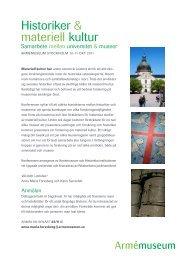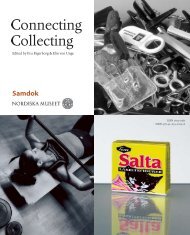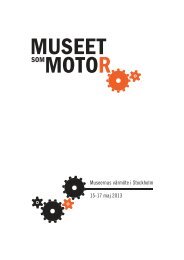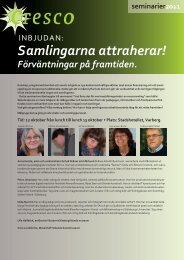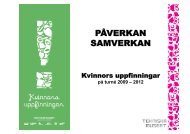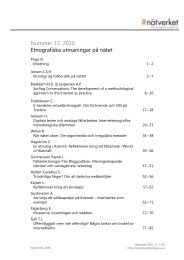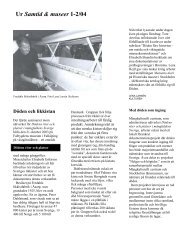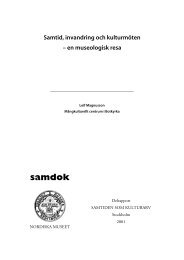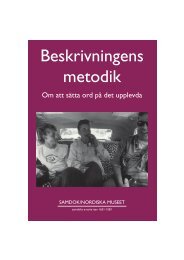Connecting Collecting - Sveriges Museer
Connecting Collecting - Sveriges Museer
Connecting Collecting - Sveriges Museer
Create successful ePaper yourself
Turn your PDF publications into a flip-book with our unique Google optimized e-Paper software.
<strong>Connecting</strong> <strong>Collecting</strong> X 30 years of SamdokA network for developingcollecting and researchBy Eva FägerborgFor thirty years, Swedish museums of cultural history haveex plored contemporary society within the framework of Samdok,the museums’ network for contemporary studies and collecting.This issue of our periodical Samtid & museer (“The Present Day &Museums”) is intended as an up-to-date presentation of Samdok’swork for an international readership.»When Samdok was established, the focuson contemporary collecting, both nationallyand internationally, broke with traditionalviews of what museums should be concernedwith. The basic tasks of cooperation in studyingpresent-day life and collecting present-day artefactsremain. In the course of time Samdok hasalso become a forum for scholarly discussions oncontemporary culture and society, a forum forprofessional development and further educationwhere we can share experiences of the empirical,methodological and theoretical dimensionsof the creation of the publicly managed and preservedcultural heritage.Organization and working methodsSamdok currently has about eighty members:county museums, central museums, municipalmuseums, and specialist museums, along withsome other institutions. The members cooperatein working groups (pools), and the core of theSamdok work is the studies and collection carriedon in the pools by the respective museums.The work is supported by the Samdok Secretariat,the Samdok Council, and Samdok’s researchcouncil.The pool system has become Samdok’sperhaps best-known characteristic. The originaltwelve groups are now eight: The group forCultural Encounters, the pools for Domestic Life,Leisure, Local and Regional Spheres, Managementof Natural Resources, Manufacture and Services,Sami Life, and Society and Politics.In recent years the pools have formulatednew guidelines/policy statements to supporttheir work. The questions, perspectives, andmethods currently being used are described inthe following articles.The Samdok Secretariat is located at andfinanced by the Nordiska Museet. As the administrativehub of the network it is responsible fordevelopment work, information, and administration.The decision-making Samdok Councilconsists of representatives of national, county,and municipal museums. The Nordiska Museet’sresearch council is now also Samdok’s scientificcouncil.In Samtid & museer (1977–96 under thetitle Samdokbulletinen) one can follow Samdok’swork and read about ongoing investigations,current research, methodological and theoreticalissues. The periodical reaches a wide audienceand is a link between the museums and othersectors of society. It appears twice a year, coveringvarying themes. Regular features alongsidethe theme articles are researchers’ diaries,presentation of new publications, and the pools’columns where they bring up topical issues forthe members.The online database Samdokregistretpresents investigations which have been done atthe member museums and reported to the secretariat.It contains details of the subjects and phenomenathat have been studied, questions andproblems, when, where, and by whom the studieswere conducted, the types of material theygenerated, and how they have been presentedand published. The source material is kept at therespective museums.Major joint seminars, conferences, andcourses are arranged by the secretariat. Autumnconferences in recent years have been devoted tovarious aspects of collecting – from the scrutinyof policy documents to discussions about therole of artefacts and the museums’ contemporarystudies in a societal perspective.International collaborationfor the futureQuestions arising today are how museums ofcultural and social history can and should studyand collect the global society. This applies bothto newly established museums and those whichmanage and expand on collections created inearlier ideological and scientific contexts. Whenthe concept of cultural heritage no longer hasa taken-for-granted local, regional, or nationalconnection, collecting must be problematized innew ways, in relation to the world and the circumstancesin which the museums act. Here weare facing a common challenge. New conditions,scientific and ethical considerations have consequencesfor collecting policies and practices, forthe cultural heritage that the museums produce.It is becoming increasingly urgent to pursue internationaldialogue and collaboration to learnabout each other’s views, methods, and experiences.In the Nordic countries we have formedthe Norsam network and we know the value ofthis kind of exchange.Samdok’s anniversary conference 2007The international perspective is the theme ofthis year’s major Samdok event, the conference<strong>Connecting</strong> <strong>Collecting</strong>, to be held at the NordiskaMuseet on 15–16 November with financialsupport from the Bank of Sweden TercentenaryFoundation. The aim of the conference is tocreate the international forum for knowledgedevelopment and collaboration that has hithertobeen lacking when it comes to collecting issues.In ICOM there are committees for the managementof museum collections, but there is nonedevoted to the considerations governing the supplyof material to the collections. We hope thatthe conference will be the starting point for aninternational network which can then be developedinto a new ICOM committee on collecting– an issue of concern for the future of museumsin all countries. pEva Fägerborg is in charge of the Samdoksecretariat at the Nordiska Museet,eva.fagerborg@nordiskamuseet.se<strong>Connecting</strong> <strong>Collecting</strong> X 30 years of Samdok»In this issueSince the periodical this time is intended togive an overview of Samdok today, it is arrangedin a different way from usual, besidesbeing published in English. This introductionis followed by a summary of two projectsconducted in recent years. The major part istaken up with articles where the pools themselvespresent their work. At the end we showpictures of contemporary Sweden, in a spreadwith examples of museums’ photo documentation.Samtid & museer no 2/07 • 3



